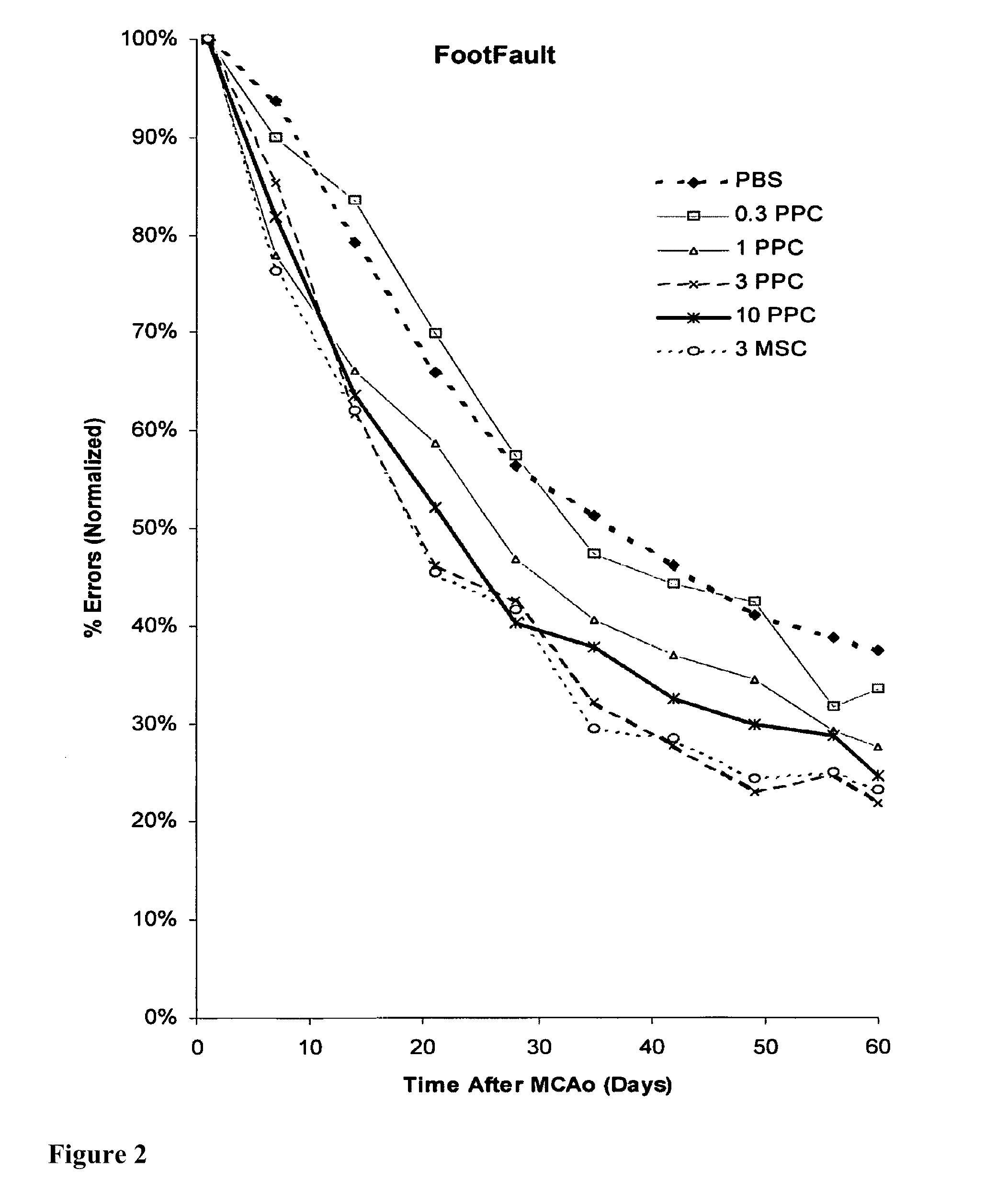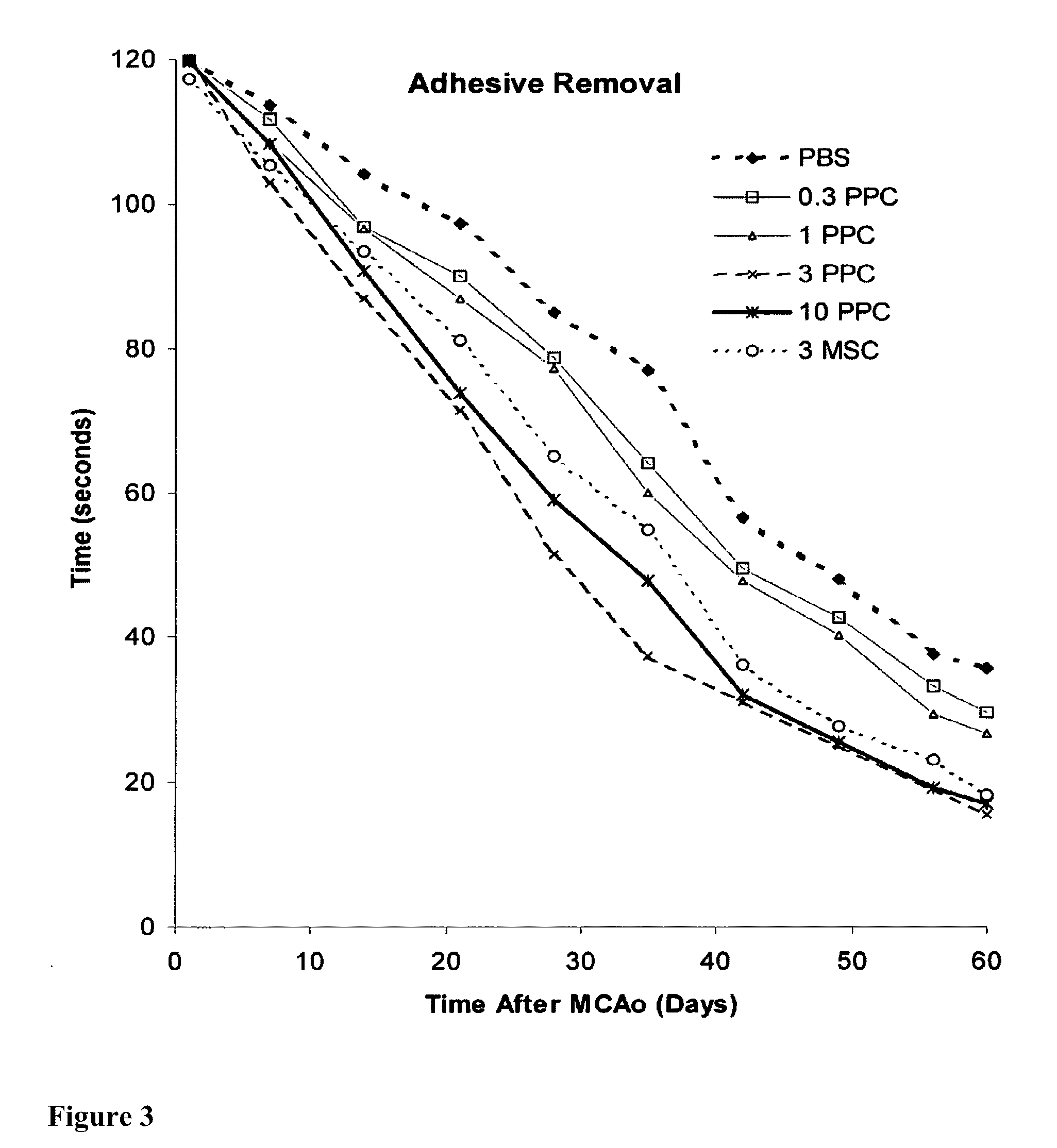Treatment of stroke and other acute neural degenerative disorders via intranasal administration of umbilical cord-derived cells
a technology of umbilical cord and intranasal administration, which is applied in the field of cell-based or regenerative therapy for stroke patients, can solve the problems of ischemic stroke, bleeding into the brain, necrosis of brain tissue, etc., and achieve the effect of increasing the expression of interleukin-8
- Summary
- Abstract
- Description
- Claims
- Application Information
AI Technical Summary
Benefits of technology
Problems solved by technology
Method used
Image
Examples
example 1
Derivation of Cells from Umbilicus and Placenta Tissue
[0209]This example describes the preparation cells from placental and umbilical cord tissues. Umbilical cords and placentae were obtained upon birth of either a full term or pre-term pregnancy. Cells were harvested from 5 separate donors of umbilicus and placental tissue. Different methods of cell isolation were tested for their ability to yield cells with: 1) the potential to differentiate into cells with different phenotypes, a characteristic common to stem cells, or 2) the potential to provide trophic factors useful for other cells and tissues.
[0210]Methods & Materials
[0211]Umbilical cell isolation. Umbilical cords were obtained from National Disease Research Interchange (NDRI, Philadelphia, Pa.). The tissues were obtained following normal deliveries. The cell isolation protocol was performed aseptically in a laminar flow hood. To remove blood and debris, the cord was washed in phosphate buffered saline (PBS; Invitrogen, Carls...
example 2
Growth Characteristics of Umbilicus and Placenta-Derived Cells
[0235]The cell expansion potential of umbilical cord tissue and placental-derived cells was compared to other populations of isolated stem cells. The process of cell expansion to senescence is referred to as Hayflick's limit (Hayflick L. (1974) J Am Geriatr Soc. 22:1-12; Hayflick L. (1974) Gerontologist. 14:37-45). Umbilical cord tissue-derived cells are highly suited for therapeutic use because they can be readily expanded to sufficient cell numbers.
[0236]Materials and Methods
[0237]Gelatin-coating flasks. Tissue culture plastic flasks were coated by adding 20 milliliters 2% (w / v) porcine gelatin (Type B: 225 Bloom; Sigma, St Louis, Mo.) to a T75 flask (Corning, Corning, N.Y.) for 20 minutes at room temperature. After removing the gelatin solution, 10 milliliters phosphate-buffered saline (PBS) (Invitrogen, Carlsbad, Calif.) was added and then aspirated.
[0238]Comparison of expansion potential of UTCs with other cell popul...
example 3
Evaluation of Growth Media for Placenta-Derived Cells
[0254]Several cell culture media were evaluated for their ability to support the growth of placenta-derived cells. The growth of placenta-derived cells in normal (20%) and low (5%) oxygen was assessed after 3 days using the MTS colorimetric assay.
[0255]Methods & Materials
[0256]Placenta-derived cells at passage 8 (P8) were seeded at 1×103 cells / well in 96 well plates in Growth Medium with penicillin / streptomycin. After 8 hours the medium was changed as described below and cells were incubated in normal (atmospheric) or low (5%, v / v) oxygen at 37° C., 5% CO2 for 48 hours. MTS was added to the culture medium (Cell Titer 96® AQueous One Solution Cell Proliferation Assay, Promega, Madison, Wis.) for 3 hours and the absorbance measured at 490 nanometers (Molecular Devices, Sunnyvale Calif.).
TABLE 3-1Culture MediaAdded fetalbovine serum %Culture MediumSupplier(v / v)DMEM low glucoseGibco Carlsbad CA0, 2 10DMEM high glucoseGibco0, 2 10RPMI ...
PUM
| Property | Measurement | Unit |
|---|---|---|
| Temperature | aaaaa | aaaaa |
| Temperature | aaaaa | aaaaa |
| Temperature | aaaaa | aaaaa |
Abstract
Description
Claims
Application Information
 Login to View More
Login to View More - R&D
- Intellectual Property
- Life Sciences
- Materials
- Tech Scout
- Unparalleled Data Quality
- Higher Quality Content
- 60% Fewer Hallucinations
Browse by: Latest US Patents, China's latest patents, Technical Efficacy Thesaurus, Application Domain, Technology Topic, Popular Technical Reports.
© 2025 PatSnap. All rights reserved.Legal|Privacy policy|Modern Slavery Act Transparency Statement|Sitemap|About US| Contact US: help@patsnap.com



